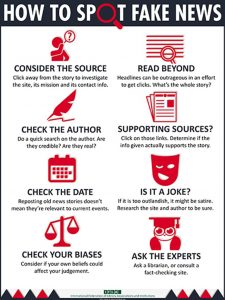Fact vs. Fiction: How Universities are Helping to Curb the Spread of Digital Disinformation
by Mary Sim
When was the last time you encountered a catchy headline or news article online, only to question the truthfulness of its content? Perhaps you were searching for an article to include in a research project or were simply looking for accurate coverage of a recent event. Clickbait, designed to attract attention by appealing to readers’ emotions and curiosity, contains unverified information rather than objective facts [1]. Sensationalized headlines are particularly harmful when they lead to the creation and dissemination of false content, a phenomenon described in a recent guest blog post on fake news.
It is important to distinguish between two types of misleading information: disinformation, false information that is intended to cause deliberate harm [2], and misinformation, inaccurate information that is spread regardless of whether there is an intention to deceive [3]. The rise of disinformation has led to the post-truth era, Oxford’s 2016 Word of the Year that describes circumstances in which “objective facts are less influential in shaping public opinion than appeals to emotion and personal belief” [4]. With the spread of false beliefs and “alternative facts,” it is increasingly important to advocate for accurate and truthful reporting.
Higher education institutions play a critical role in combatting disinformation. Across Canada and internationally, universities have established initiatives that promote digital literacy and enable students to become critical consumers of information. Read on to learn how to distinguish fact from fiction and avoid sharing false news online.
1. Fake News Detection
Many academic libraries offer subject guides designed to build digital literacy and encourage students to recognize misinformation [5]. The following infographic provides a step-by-step guide to spot fake news by checking the source, date, headlines, and claims.

Image by IFLA used under CC-BY 4.0 license
When combining this approach with fact checking websites such as FactCheck.org and Snopes.com, readers can verify information. The newly-updated Digital Tattoo Fact Checking Tutorial is a helpful resource that provides an overview of fact checking and fake news and allows readers to test their knowledge.
2. Critical Information Literacy
The ubiquitous nature of the digital world has made it increasingly challenging for traditional gatekeepers such as media outlets and journalists to control and verify information [6]. To combat the spread of fake news online, librarians are shifting from fact checkers to educators and teaching students critical thinking and information literacy skills.
The SIFT model, developed by Mike Caulfield, a digital information literacy expert at Washington State University, was created in response to the spread of misinformation during the COVID-19 pandemic [7].
SIFT stands for: Stop, Investigate the source, Find better coverage, and Trace claims, quotes and media to the original context. This method encourages university students to evaluate and contextualize information sources and learn strategies to sort fact from fiction online.

Image by Mike Caulfield used under CC-BY 4.0 license
3. Online Games
Bad News Game, developed by scientists at the University of Cambridge in collaboration with Dutch media platform DROG, is an award-winning fake news intervention that aims to improve media literacy and social impact [8]. By exposing people to weakened doses of misinformation, players build cognitive immunity and resistance to fake news in a process known as psychological inoculation [9]. Allowing players to take on the role of a fake news producer enables individuals to develop confidence in spotting misinformation and ultimately builds resistance against future manipulation.
Try the game here: www.getbadnews.com
What methods do you use to spot disinformation? Do you know of other ways that universities are helping to detect and deter disinformation online? Leave a comment below or start a discussion on Twitter and tag @DTatUBC
Further reading
Cooke, N.A. (2018). Fake news and alternative facts: Information literacy in a post-truth era. ALA Editions.
McIntyre, L. (2018). Post-Truth. MIT Press.
O’Connor, C. & Weatherall, J.O. (2019). The misinformation age: How false beliefs spread. Yale University Press. DOI: https://doi.org/10.2307/j.ctv8jp0hk
References
[1] GCFGlobal. (n.d.) The now: What is clickbait? Retrieved June 11, 2021, from
https://edu.gcfglobal.org/en/thenow/what-is-clickbait/1/
[2] UNESCO. (2021, May 7). Journalism, ‘fake news’ and disinformation: A handbook for journalism education and training. Retrieved June 11, 2021, from https://en.unesco.org/fightfakenews
[3] University of Washington Bothell & Cascadia College Campus Library. (2021, May 27). News: Fake news, misinformation & disinformation. Retrieved June 14, 2021, from https://guides.lib.uw.edu/c.php?g=345925&p=7772376
[4] Oxford Languages. (n.d.). Word of the Year 2016. Retrieved June 14, 2021, from
https://languages.oup.com/word-of-the-year/2016/
[5] University of Toronto Libraries. (2020, November 3). How do I spot misinformation? Retrieved June 14, 2021, from https://onesearch.library.utoronto.ca/faq/how-do-i-spot-misinformation
[6] De Paor, S. & Heravi, B. (2020). Information literacy and fake news: How the field of librarianship can help combat the spread of fake news. The Journal of Academic Librarianship, 46(5), 102218. https://doi.org/10.1016/j.acalib.2020.102218
[7] Caulfield, M. (n.d.). Sifting through the coronavirus pandemic. Retrieved June 14, 2021, from https://infodemic.blog
[8] Cambridge Social Decision-Making Lab. (2020, July 28). Bad news game.
https://www.sdmlab.psychol.cam.ac.uk/research/bad-news-game
[9] Basol, M., Roozenbeek, J. & van der Linden, S. (2020). Good news about bad news: Gamified inoculation boosts confidence and cognitive immunity against fake news. Journal of Cognition, 3(3), 2. http://doi.org/10.5334/joc.91
Written by Mary Sim
Edited by Rachael Bradshaw
Featured image People Sitting on Chair in Front of Table by Mikhail Nilov via Pexels License

